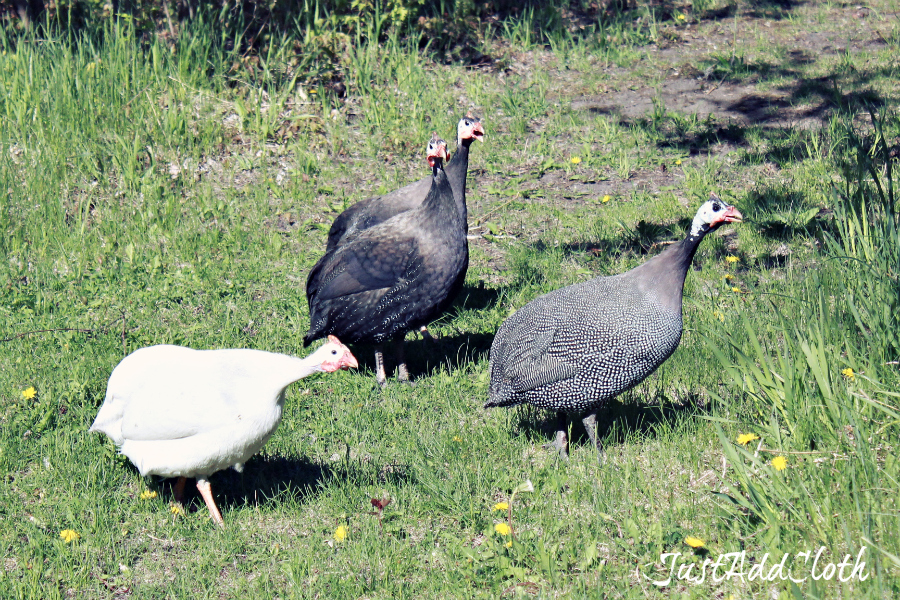
The Ultimate Guide to Raising Guinea Fowl
You probably started out with a hankering for a few backyard chickens. They looked so quaint and that whole urban homesteading trend is just so adorable and who wouldn’t want fresh eggs? If you lived on the edge of town or somewhere a little more rural, you likely then fell victem to “chicken math” and grew your flock far beyond the needs of your family. It happens to the best of us. Maybe you added a few ducks. Rescued some roosters. Adopted a couple goats. Now you are a bonified hobby farm, or maybe drop the hobby part because it has become your life, and you decided to go to the next level in homesteading insanity: The Guinea Fowl Flock.
Make no mistake. It WILL be a guinea flock. And you know this because you already read up on guineas and learned they are notoriously dumb and need a decent sized flock to survive, much like a heard of wildebeest. It is a numbers game and they Darwin themselves off on a pretty regular basis.
After raising my own guineas as well as watching the other guinea flocks marauding all over the county, I’ve picked up some knowledge that isn’t all fluff and decided to share. Guineas are fun. And cute in that so-ugly-they’re-cute sort of way. However, they are nothing like other fowl and it would be a good thing to learn that before you decided to raise 60 keets and completely destroy your homestead. Knowledge is power!
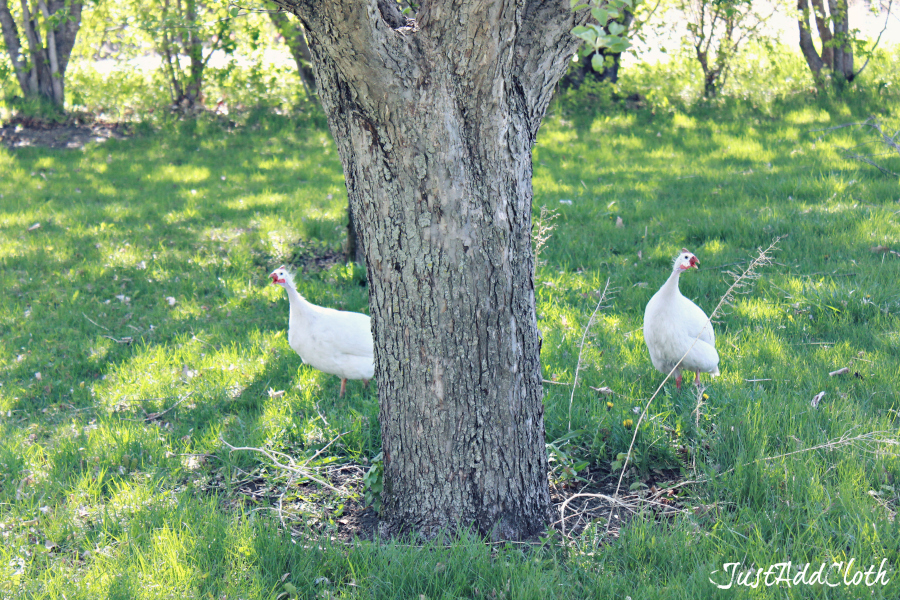
The Nature of Guineas
Guinea fowl tend to remain undomesticated for a number of reasons. Their social structure is less conducive to optimal breeding control. Since they generally only survive in a large flock, they tend to kill themselves off fairly easily, so it can be difficult to breed for selective traits. They are not the best parents to their offspring, so it is more of a group effort, without natural selection getting very complicated. They do not follow the pack as much as chickens do, so training them can also be challenging. Very few guineas respond well to structure. Their nature simply does not play well with becoming domesticated livestock. Think crazy toddler birthday party hopped up on sugar and caffeine 24/7. This can make for a very entertaining flock of birds to have around, but get rid of any fantasy you have of them being as docile or easy to manage as your chickens. I would say less than 20 percent of my guinea flock was reasonably trainable. And I am being generous with the term reasonable!
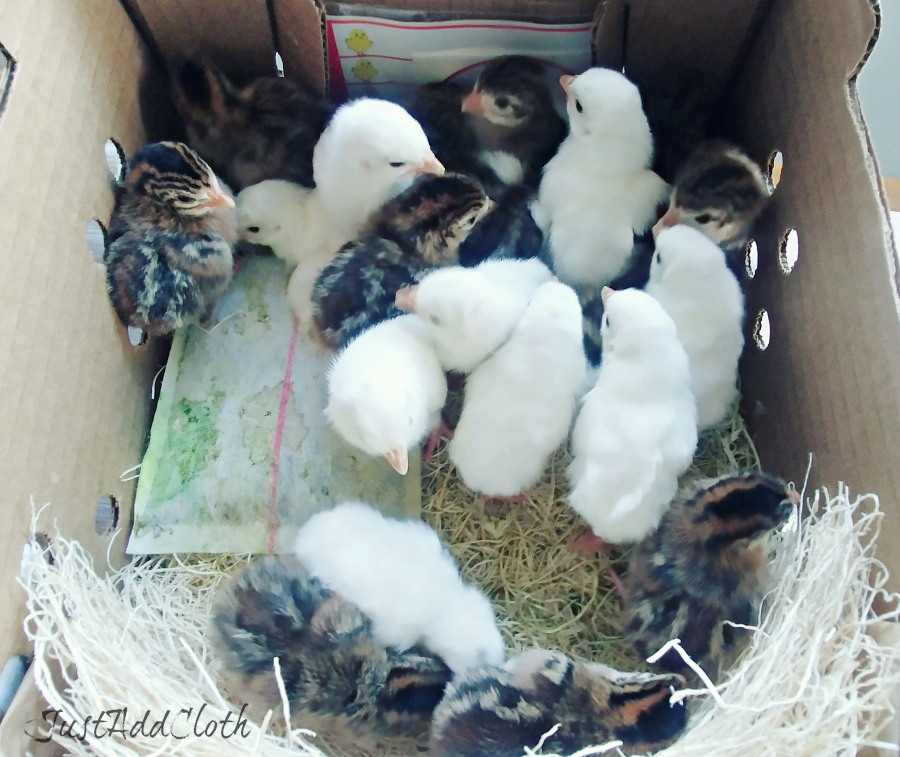
Getting Keets
Only order your guinea keets in warm weather. Keets are teeny tiny and very susceptible to chill. They are much more sensitive than chicks. Most hatcheries will only hatch and ship guinea keets June to early September anyway. BUT, if you find a place shipping outside of that range, don’t bother ordering unless you are both located in Florida. Those little warming packets in the box are not enough to keep them alive.

Our DIY Chick Brooder Setup
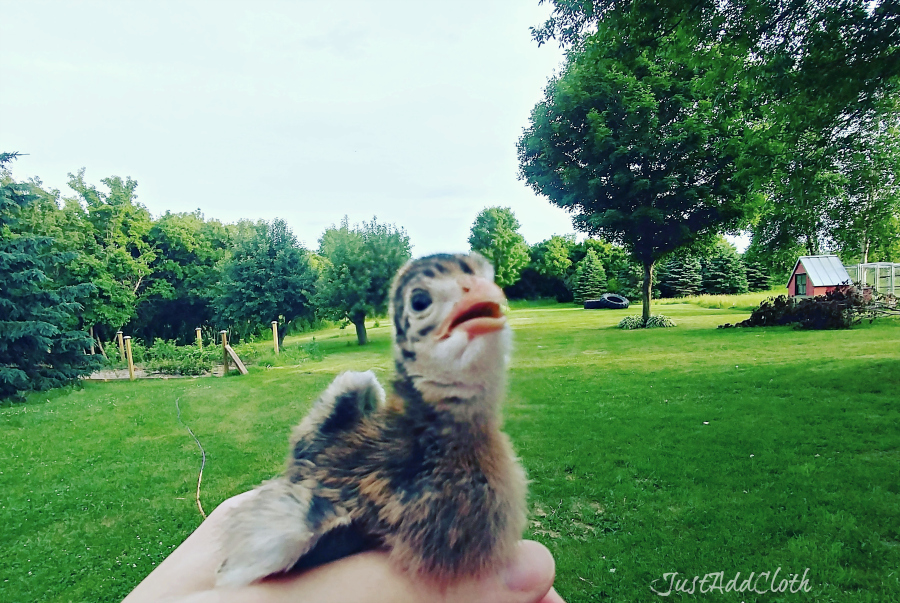
How to Set Up A Guinea Brooder
Supplies:
-a container
-heat source
-absorbent litter/bedding
-water for drinking and head dunking
-chick feed
Container
The container that makes up the brooder needn’t be fancy. It just needs to keep them safely contained, have plenty of air flow, have access to bright days and dark nights, and a dry warm area for sleeping. Some people can create a brooder area in a barn, but we live in a very cold climate and need to raise chicks, keets, and ducks in our house for a long time. Keets are especially susceptible to cold, so I suggest keeping inside.
We use a large 6ftx2ft metal water trough. This worked fine for 20 guinea keets for a couple weeks until they started hopping and flying out around the house. If you live in a cold climate like we do, I recommend not getting your keets until June so you can move them to an outside brooder area by three weeks.
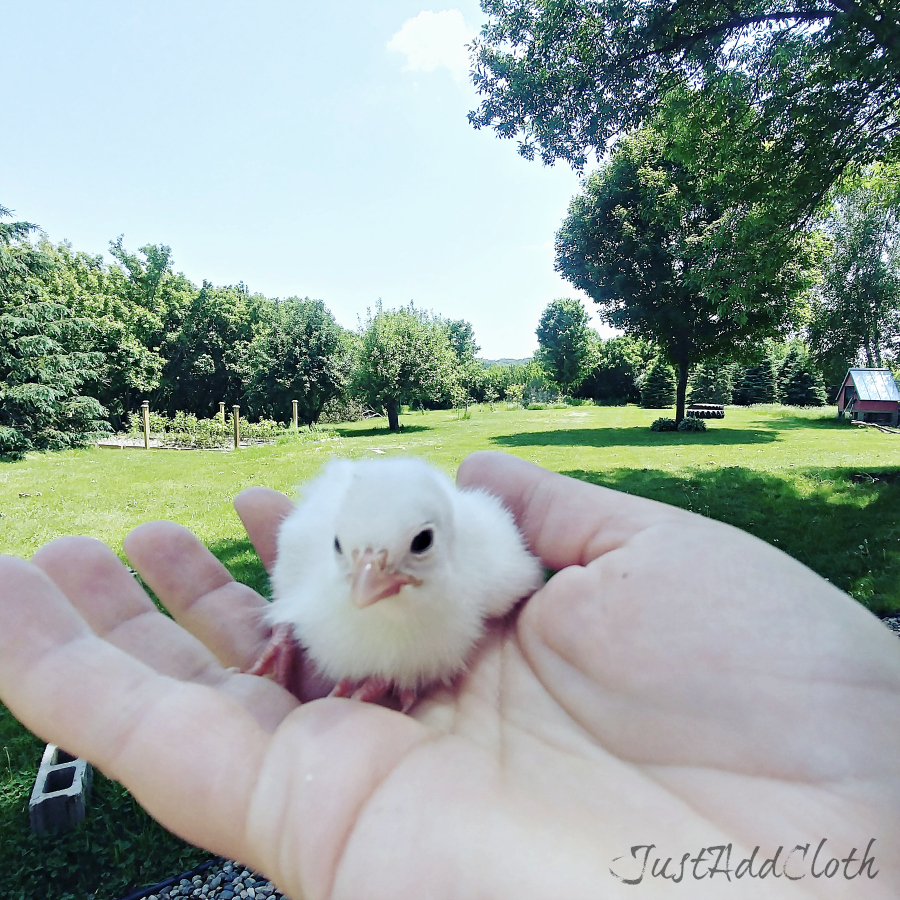
Heat
I am not a fan of heat lamps since they can be a fire hazard and they tend to heat up the entire area. If the entire brooder is hot, the birds have no where to go if they feel too warm. I use a heat plate that sits up on stilts. This way the guinea babies can frolic and play, then choose to go the warm area.
Keep the warm area dry and away from the water. Keets can get chilled easily so you don’t want the warm bedding getting wet. The moisture combined with warmth can grow mildew and mold very quickly which can be very bad for young fowl’s respiratory systems.
Litter
Use pine shavings, paper shreds, and even straw hay as litter. Since keets are small, I don’t recommend hay until they are three weeks of age. I layer newspaper over the metal of the trough since plain shavings on the metal floor is too slippery.I lay paper towels over the newspaper for a grippier surface. Then we mix pine shavings and straw over the paper. We keep the water on one end and warmer on the other end.
Once keets are in preteen age, move to a coop they stay in for a few weeks much like a giant cage for a parrot.
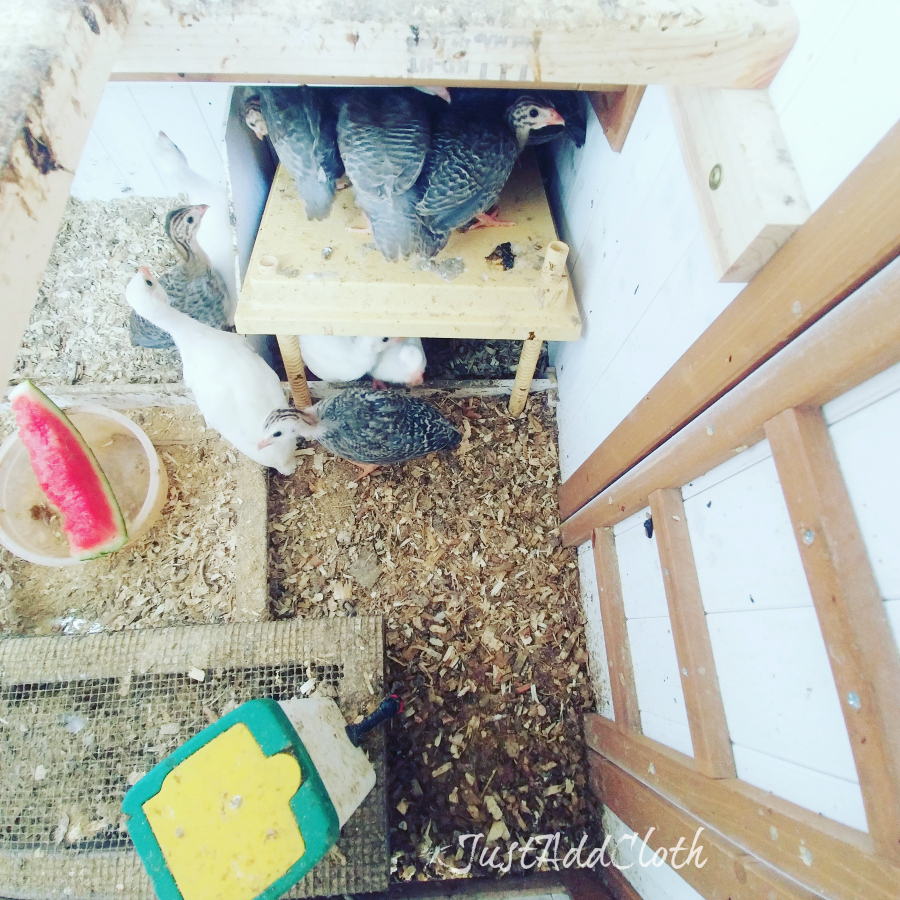
Water
Keets shouldn’t splash around until older, so I prefer a nipple waterer for keeping everything clean and dry.
Feed
Unmedicated chick starter is just fine for guinea keets. I sometimes would use a higher protein mix for pheasants for the keets, but it really isn’t necessary. Do not give them layer pellets until around five months. (I always break this guideline because once birds are too big to keep inside I just integrate them in to the flock of mature birds. So, mine always start eating layer pellets way sooner than recommended. It has never been a problem for us, but we also free-range our fowl so a lot of their food comes from foraging instead of pellets.
Coop, Run, pasture & Free-ranging
So let’s talk coops. There a ton of different ways to set up your chicken coop. It really depends on your location, your climate, and how many birds you keep.We have a couple dozen large heritage chicken breeds, several pekin ducks, and 17 guinea fowl at the time I write this. We live in the country with foxes, coyote, and birds of prey. We live in Minnesota, which means it can be -40°F in winter and 110°F in summer.
This coop has a steal roof, spray insulated walls, triple pane glass windows, 4×4 frame posts and it’s own little porch underneath. It is sturdier construction than the house we actually live in. It also weighs a thousand pounds and was a real treat to pickup and maneuver into its new home. It was worth every penny.
The homestead we purchased had a dilapidated old coop and dog kennel on the property, so we refurbished and repurposed. We cut openings in the cyclone fencing for the coop doors to open up through the fencing. Then used lumber staples to attach the fencing to the coops to keep it gap free and secure. We further secured the chicken yard by covering the top of the run with hardware cloth wired to the kennel frame. Then we dug an 18 inch deep trench around the run and wired hardware cloth to the cyclone fencing and buried it 18 inches deep in the trench. This makes it difficult for predators to dig under the fence. Although, a really dedicated animal could of course tunnel under.
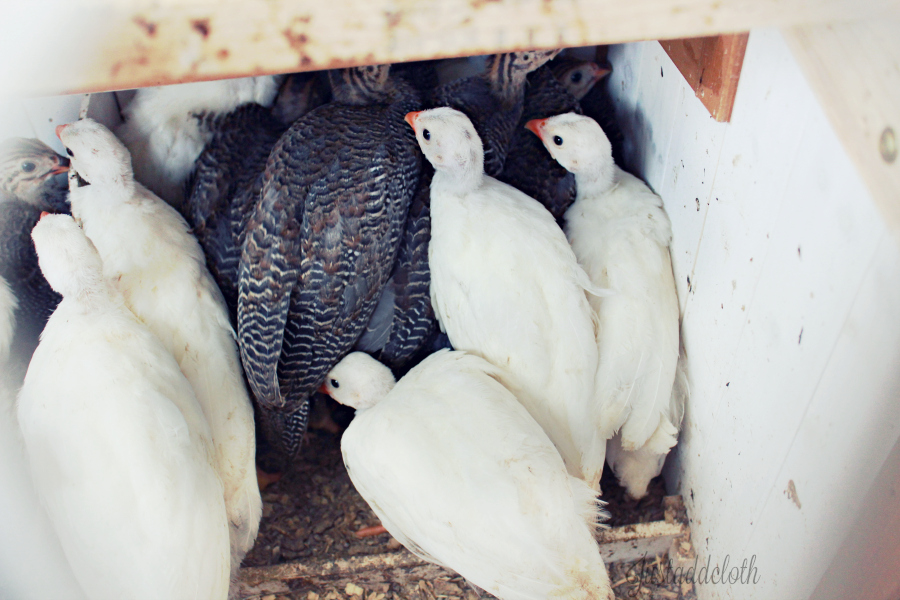
The covered run consists of FOUR 10×10 kennel kits at six feet high, withe the outer coops added, it is about 500 square feet of protected space. We also have the three sided duck house, and two additional small cheap coops within the protected run. this makes up all of the protected space for the whole flock. however, that space is really only used at night, especially for the guineas. The fowl pasture is a 10,000 square foot area contained with our DIY Farm Fencing. while it keeps the chickens and ducks from wandering off or destroying the gardens, the guineas fly right over and go where they please. They free-range across our property as well as the porperties of any neighbors. So far as I can tell, they do not wander more than a mile from home.
Food
We feed our guineas the same feed as our chickens and ducks. I use a standard layer pellet feed, not all flock. And in Summer, they mostly just eat what they find in the pasture.
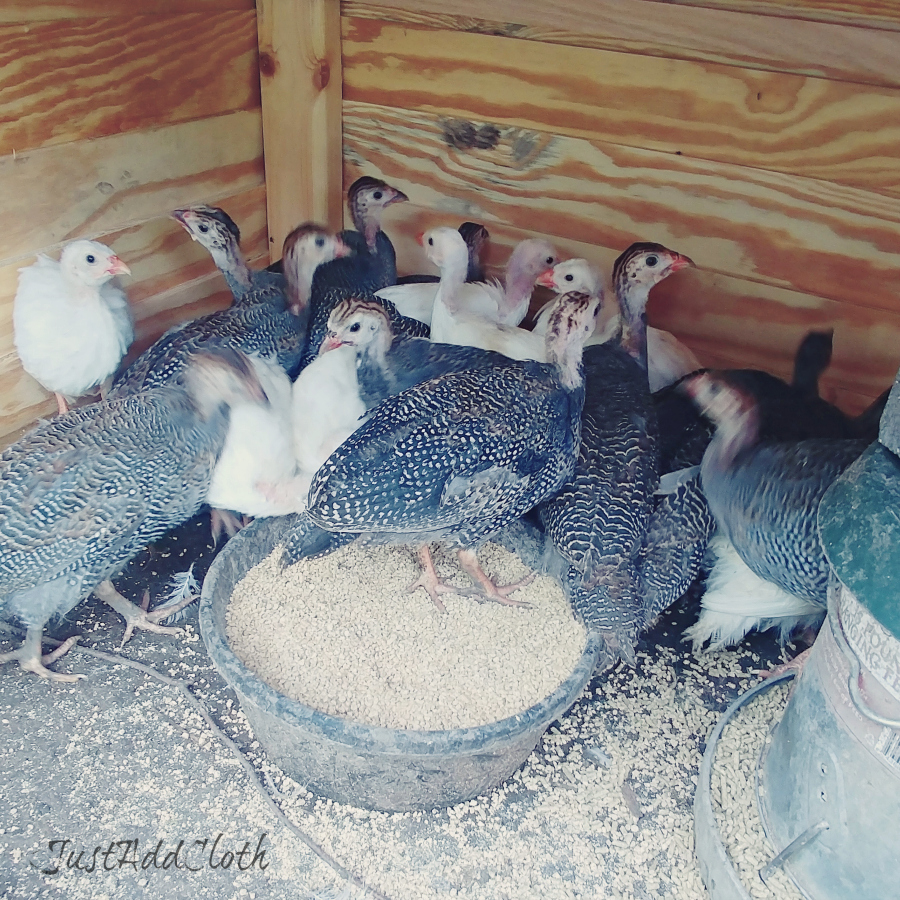
Water
We use the same water system for guineas as other birds. We fill a big black rubber tub each day as well as several DIY nipple waterers made with buckets from the hardware store.
Training
Teenage guineas (4 to 6 weeks) can go out in the run, but keep them in a protected run, no free ranging. I recommend raising them with a few chickens to help train them. Guineas take a long time to train. In a perfect set up, I would keep them in a covered run for a year since in my experience, it takes about that long for them to get with the program and figure out that following a routine means more food and less dying.
For optimally trained guineas, I would only add maybe six to a large flock of chickens, so that they learn chicken routines. My experience with large guinea flocks, is they basically need to Darwin out about 80 percent of the flock and then the 20 percent you are left with are the ones smart enough to stay alive by following the rest of the animals in the evening. Overall, guineas are difficult to train at all. This is why they are not considered domesticated. Even after years of trying to get them in the protected run at night in a standard routine, they are like trying to guide a class of three year olds on the first day of preschool.
Guineas can fly fairly high, so fencing them in is pointless. They will fly over any barrier you build and decimate your gardens. While they tend to not eat up your vegetable like chickens do, they will scratch up all of your starter plants. So if you do plant crops/gardens, keep the plants netted until they are very well established or you will yield nothing for the season. Our guineas have destroyed entire fields of freshly planted corn. If anything, you want fake crops nearby to distract them from your real crops. Or a huge area of manure and compost for them to sift through, while you sneak off and plant your garden.
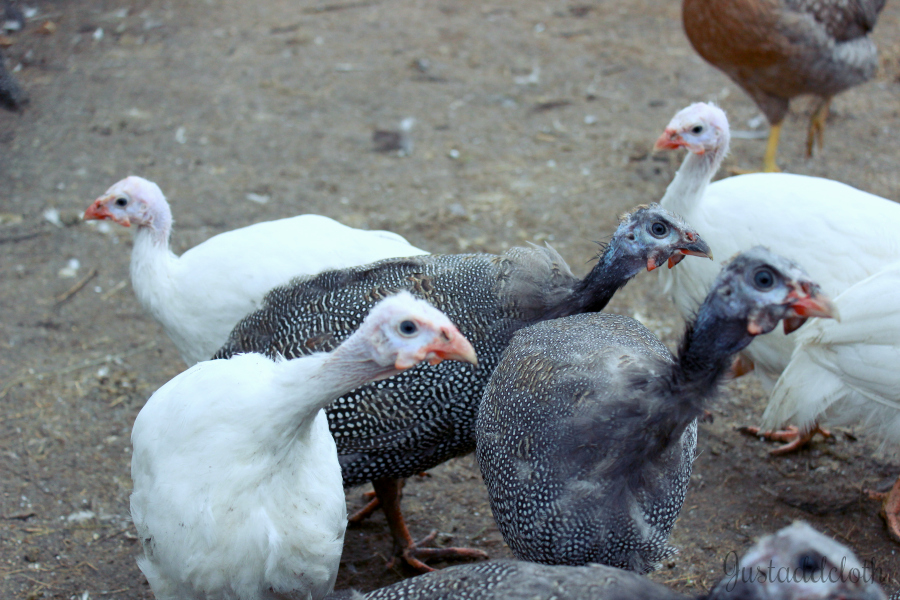
Noise
The Males sort of squawk and “keet”. The females make the real noise with their more pronounced call. Some say it sounds like they are saying “buckwheat”. I hear it more like “buckquaaaaaay, buckquaaaaaay, buckquaaaaaay!”. Imagine watching Hyacinth Bucket answering her telephone and doing her insecure “Bouqueeeeeeeet residence!!”.
So many people consider guinea flow to be like barnyard watchdogs. Yes, they do alert you to strangers, animals, and danger. However, they also alert you to clouds, wind, sunshine, each other, chickens, squirrels, blades of grass, and their own shadows. All in all, they never shut up. It becomes a boy who called wolf situation and you stop paying attention. They also have a tendency to never sleep and continue squawking all night long, so If you do pen them up at night, I suggest it be far from your bedroom window.
Entertaining Guinea Antics
Guineas are hilarious. Once you watch them a few weeks, you’ll find they are not the most brilliant animals. There is a reason they only really survive in a big flock. When they try to get out of the coop in the morning, every time is like the first time. I am not sure what the long-term memory development process is for these birds, but geniuses they are not. They run into the walls and windows every time and seem to only find the door by accident, day after day, year after year.
However, they are not entirely untrainable. They do figure things out. The flock will walk around the house, looking in all of the windows until they find me and then sit outside the window squawking for my attention to give them treats. I have tried to use this affinity for treats to train them further and it has not worked. I think when they seek me out, it is more that one of them is smart enough to do so and the rest play follow the leader.
They also love to mess with traffic. Our guineas, and your’s too, will wander. They will wander miles. They eventually make their way home, but it might take a couple days or even weeks. Most of our neighbors are a mile of two away, and they will tell us about our guineas hanging out in their yards. Or about coyotes taking off with them. I also see random guineas frolicking down the highway in our general area. Many farms around here have guineas, and all of them manage to stop traffic by taking over the roads.
Wintering Chickens in a Harsh COLD Climate
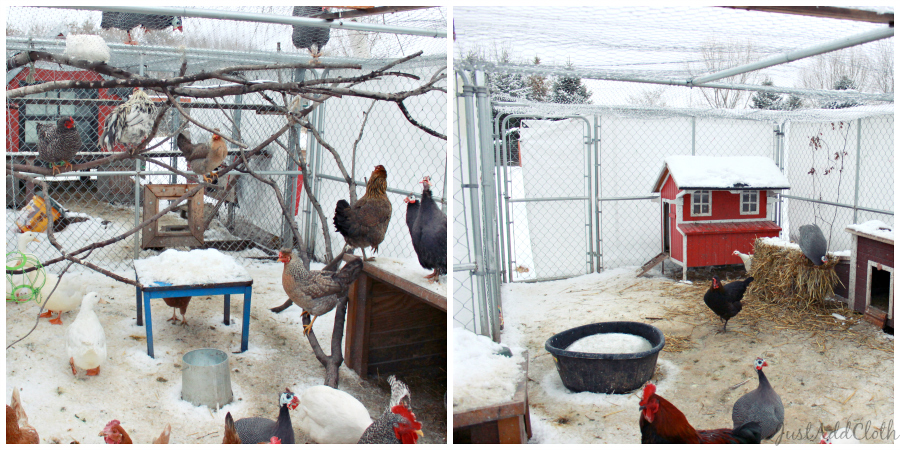
Wintering guineas
The Coop
-Don’t heat, acclimate
If you heat a coop, the chickens won’t acclimate to the cold well. Then, when something happens to the heater or the power goes out, those poor birds are goners. Instead, don’t use any heat. Let their bodies get used to temps as they drop naturally. Everyone I know who lost their chickens in our harsh winters, lost them all when a heater went out. And those same people stopped using heaters and haven’t lost an animal since. Artificial heat makes the animal weak and unable to adjust.
-Deep litter
You mostly want deep litter (leaves, dried grass, pine shavings) in a winterized coop so that you don’t have to scrape poop as often. When it is -40° with a -87° wind chill, no one wants to scrape poop. Also the litter offers more debris for the droppings to land in. Otherwise you just have frozen droppings stuck to the floor. The litter also composts which creates a bit of natural heat, but this should not be your goal.
-More venting is better than less
Moisture in the chicken coop is what causes frostbite on waddles and combs. This moisture can come from too much poop, and too much chicken breath in the air. It will also come from humidity from melt. Temp fluctuations causing melt, increase frostbite. My birds only get frostbite when the weather has big temp changes. So, the swings in weather in the Fall and Spring can hurt my birds, but they are just fine when it is consistently below zero degrees Fahrenheit.
-Block the Wind
Our coop has a screened patio as the first floor, so we use corrugated plastic and ratchet straps to cover the screen when the weather turns cold. If you desire to use this method on certain windows and screens, try to find the clear plastic so the birds still have natural light.
-Wind block with vegetation and sturdy tarps
I once read about someone recommending shower curtains as a wind block on the run in winter. I was dubious. I purchased a bunch of higher end curtains only to have them be shredded within an hour. Obviously the person I got this idea from did not live on the plains, AKA the land of no wind breaks. An average day is a constant 40 mph wind. And in winter it gusts to 120 mph. Our public schools are canceled a lot. Haha.
So I recommend the sturdiest tarps you can afford. Make sure they are white so that your run is as bright as possible. Our winter is about six months long and we don’t want the animals shrouded in darkness that whole time. Don’t bother with plastic sheeting, it just tears up immediately unless your run is in the woods or a barn. You want all-weather tarps with a continuous weave and metal grommets.
–Only do a roof if it can support a few thousand pounds
People really underestimate the weight of snow. Considering how many house and garage roofs cave in from too much snow, killing entire families inside, I’m not about to try to put a roof on a chicken run. We just have hardware cloth wired over the top for predators. The snow still accumulates on the chicken wire and hardware cloth causing it to sag, so we do have to go out and shake it off every few hours during storms.
–Add hay bales to the base as extra wind blocking
Line the outside of the run with the bales laying over the tarp bottoms. And then when the spring melt begins you can use that hay for all the mud. Even better, line the inside of the run with bales as well. Although, this can get expensive if your don’t grow your own hay.
Food
-Keep it sheltered from snow
I keep it in the “food and socializing coop”. Our birds sleep in one coop and then eat and hangout in another. It forces them out and gives them more activity and stimulus in the boring winter months.
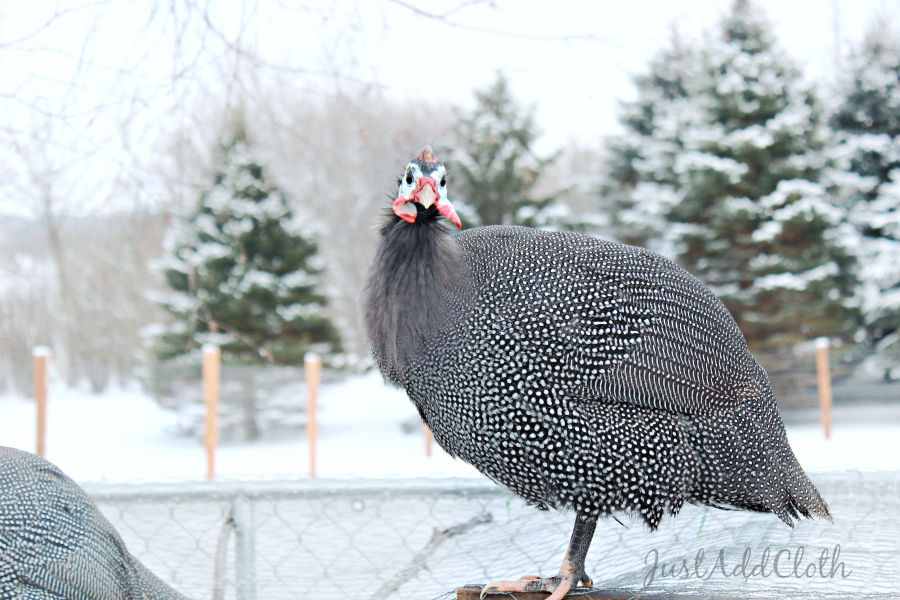
Water
-Don’t bother with warmers
If you have real winter, they don’t work below zero degrees.
Instead we use a rubber tub and fill it half way with hot water. Then add a gallon of hot water periodically through the day to loosen and melt the ice. Dump out the ice block every other day.
Having a couple ducks can help since they are more aggressive with pecking through the ice. The round, black rubber tub shown below is from Tractor Supply Co. Get the big one. It takes longer to freeze up. Don’t use plastic, it just cracks right away when the water freezes and expands.
Eggs
Unfortunately, there isn’t much you can do about eggs freezing and bursting other than to run out to the coop every 45 minutes all day. During the worst of the cold months, we don’t get a ton of eggs. Technically, you could run electric and have a seed germination mat in each laying box to add some warmth, but in a truly cold winter those will work as well as a water warmer. Here’s the thing, no one raises guineas in the north for the eggs anyway. They really don’t lay much in the winter.
Guinea Egg Laying
Once your guineas start laying, they are pretty good egg producers. They will lay daily, sometimes twice. However, most of the eggs will be in random places or in hidden nests you find too late. A few of our guinea hens lay in the chicken boxes, but they are in the minority for sure. Most of the guinea eggs we get are in clutches randomly nested throughout the nearby woods or in our burn pile. Or under the sumac. If you find a clutch of eggs early enough, you can gather them for eating. However, make sure you know how long they have been sitting there. Anything longer than a few days is best avoided. You don’t want to crack open a partially developed keet or an old rotten egg.
Guinea eggs are smaller than chicken eggs with thicker shells. They are generally beige colored with some light brown speckles. The shells are thick and tough like a duck egg, and the yokes are a rich orange color. The colorful yokes are also a richer flavor than most chicken eggs. The guinea eggs are very popular with our egg clients! In fact, our guinea eggs are the most popular for flavor, while our duck eggs are popular for the novelty.
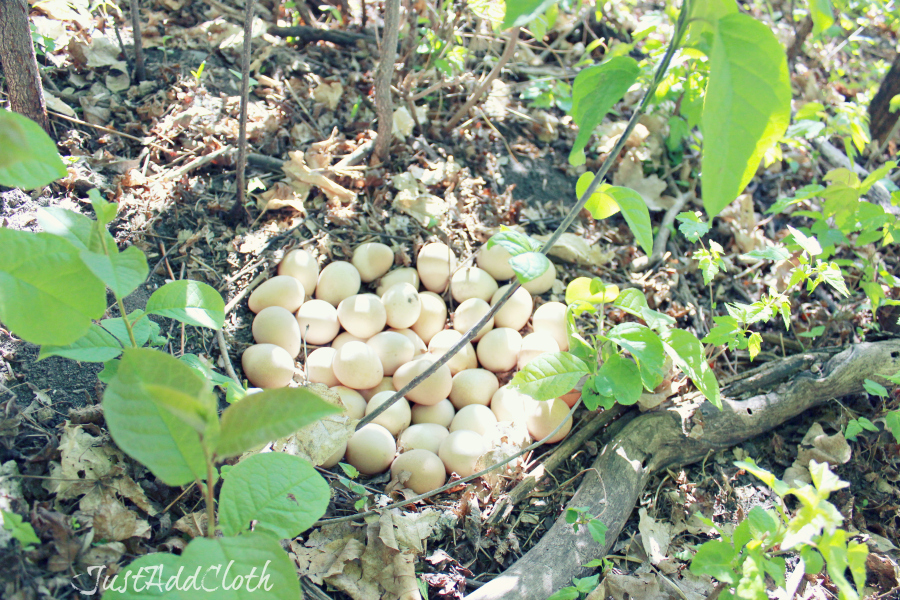
Guinea breeding and hatching
My guineas paired up after about one year of age. Depending on the size of your flock and the setup, they may lay a clutch of eggs and tend to it as a pair, or a group of guineas may have a shared clutch of eggs. Often, I’ll see females lay eggs in another’s clutch and then have nothing to do with it. They don’t seem to have any qualms about leaving their eggs to be hatched by another mother. They also tend to not be great parents over all. Keets are tiny and get chilled easily, yet the parents will just lead them around through damps grasses on chilly days without stopping to let them get warm in mama’s down. If you can get a broody chicken hen to hatch and raise your guinea keets, they probably have a better chance of survival!
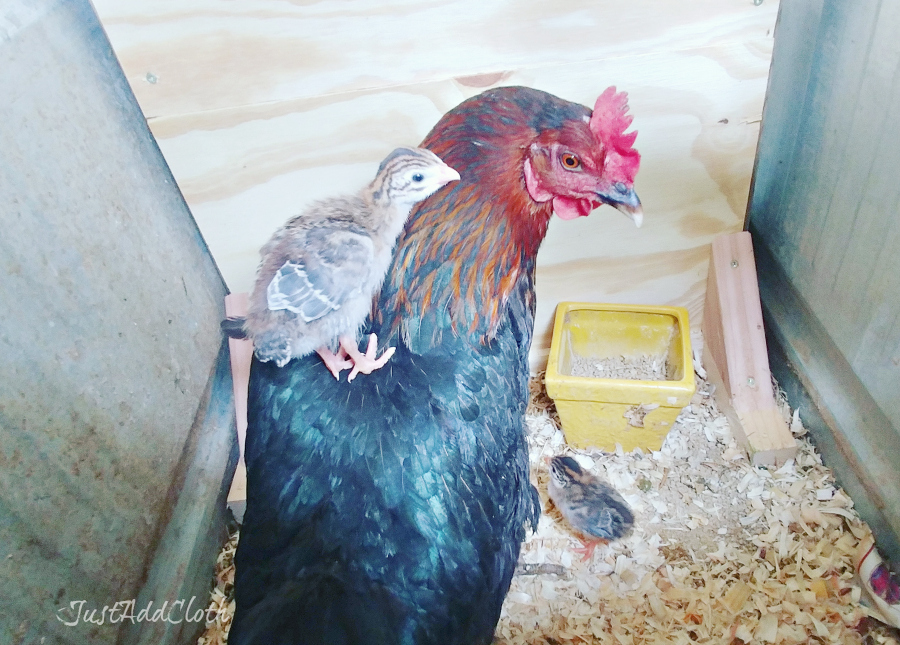
If I haven’t convinced you to NOT get guineas, let’s recap. They are noisy. They are dumb. They don’t train well or at all. They tend to die easily. They lay their eggs anywhere, making collecting annoying. They won’t put themselves to bed. They fly away.
Still want them? Let me validate your feelings! They have lovely plumage and drop tons of feathers for you to collect to make unique earrings. They are funny. Their heads freak people out. They walk down the highway and stop traffic. They annoy your neighbors. They feed your local coyote population. They eat ticks and spiders. They have delicious eggs. They will follow you for treats like puppies. They are great conversation starters.
Honestly, if you have enough acreage to have a flock of guineas and not piss off everyone else in the area, go for it. I like the little buggers. My husband, the gardener, not so much. But, even if you end up hating them, they are easy to harvest and then you’ll have a freezer full of delicacies that would be very expensive at your exotic meats butcher.
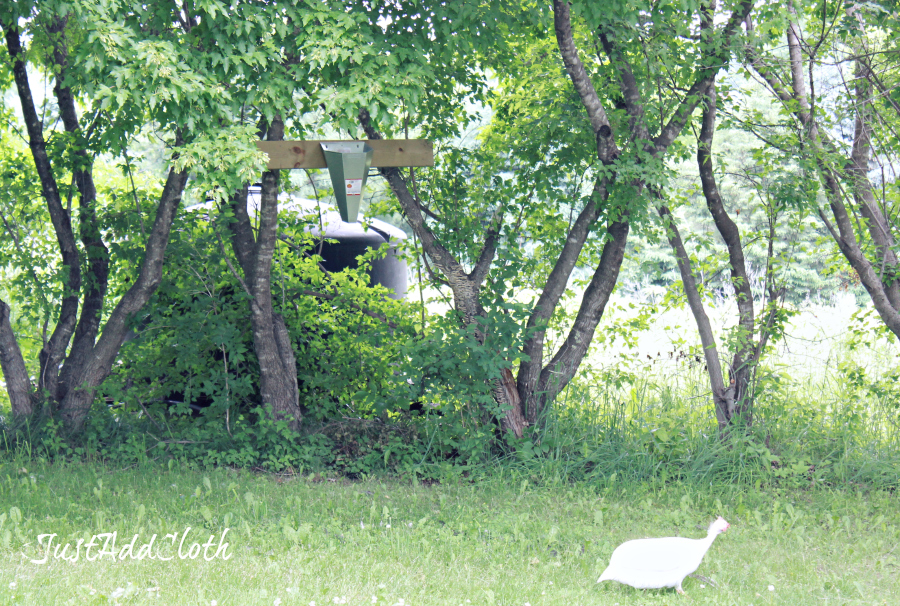


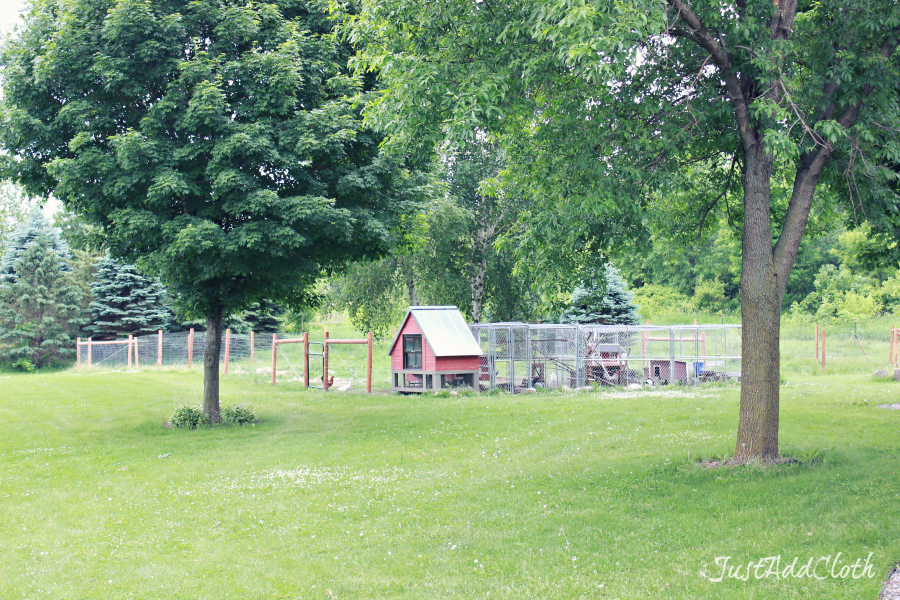
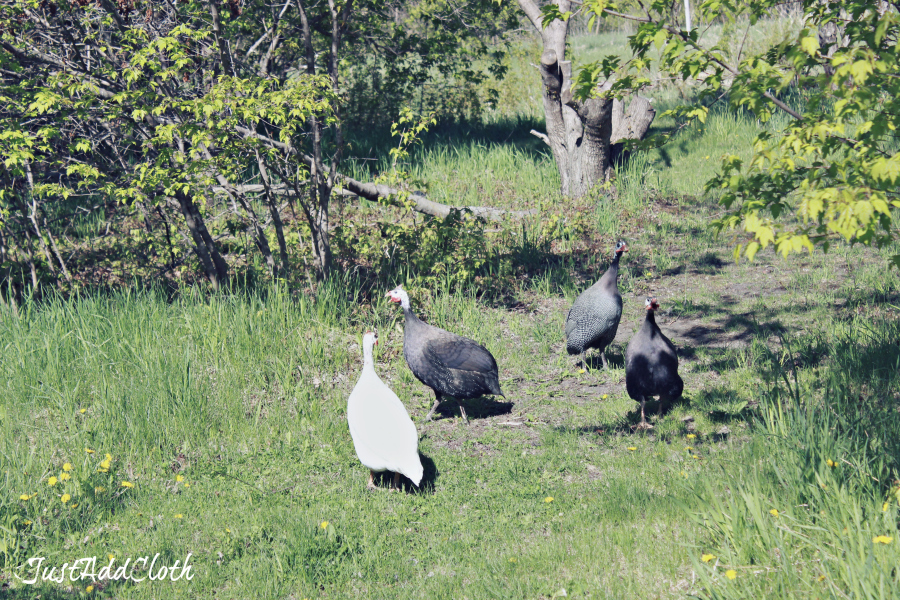
Pingback: A Quick Guide to Raising Ducks • Lake and River Studio
Hi- so you seriously are not supplying any heat to the hens or guineas and they are managing? IM asking this because I moved from Missouri to a deep coulee in W Wisconsin that gets very little and no sun in the winters and have watched everything from my LGDs to the birds suffer from the super cold temps. Since guineas are keeping my property tick free, I really dont want to lose them to cold.
The hens go into the vinyl covered 30 x 12 hoophouse all winter to fertilize, scratch and eat what they find at the end of season. I dont collect eggs in winter. Youre saying they absolutely can handle it?
Ive had guineas fail & come to absolute standstills in snow in Mo when it would get unusually cold there ( -10) and Id have to go save them, bring them inside.
I would rather not have to run electric to these birds in winter here. So if the hens and birds can deal with it, Id let them if I could.
Hi Connie.
I have never provided heat to the birds despite it getting to -35. However, we did wrap our run in tarps and stack hay bales to protect them from the wind. For much of the winter, we would keep the birds in the run on the super cold days since the guineas are difficult to round up. I will say the ducks help a bit with keeping the bigger water trough from freezing over as quickly, but frozen water is definitely an issue. I had to change out the water often. Our only casualty was one guinea who lost his feet when they froze to the ground. He survived but “Stumpy” was not the greatest runner after that. I think you can avoid heating a coop if you can keep them in an enclosed area where they are forced to be with the other birds.
I have tried some immersible heating elements for the water, but none of them worked for subzero temps. If you have a rec for that, I am all ears.